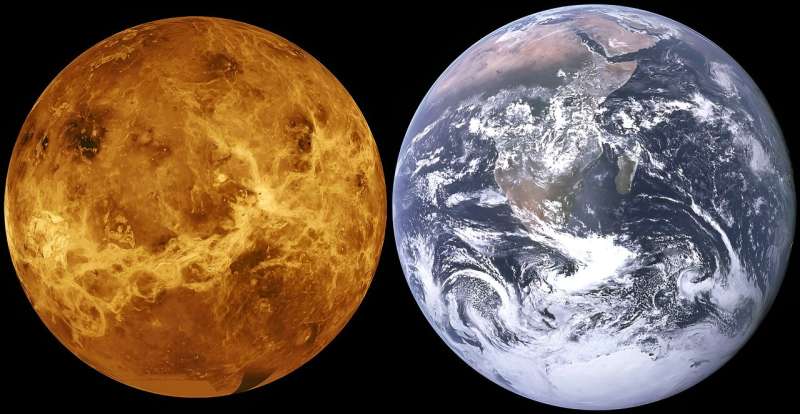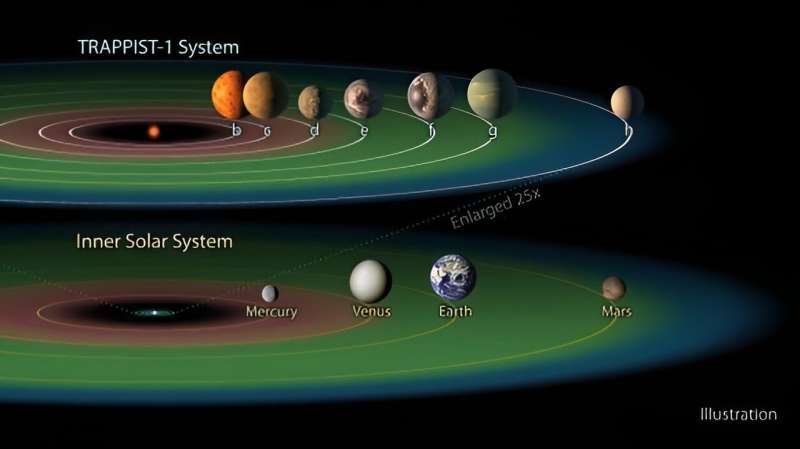This article has been reviewed according to Science X's editorial process and policies. Editors have highlighted the following attributes while ensuring the content's credibility:
fact-checked
preprint
trusted source
proofread
Can JWST tell the difference between an exoEarth and an exoVenus?

As of October 2023, astronomers have discovered 5,506 exoplanets orbiting other stars. That number is growing daily, and astronomers are hoping, among other things, to find Earth-like worlds. But will we know one when we see it? How might we be able to tell an Earth-like garden from a Venus-like pressure cooker from upwards of 40 light years away? Is JWST up to the challenge?
In a paper released in pre-print
on the server arXiv, four researchers used a simulation to put the
This simulation worked like this: The researchers placed six Earth-like planets and six Venus-like planets 40 light years away, each with varying levels of carbon dioxide (CO2), cloud cover, and haze in their atmospheres. The simulated planets orbited around a star identical to TRAPPIST-1.
In the real world, TRAPPIST-1 is one of the most promising systems discovered so far in which astronomers hope to find an exoEarth. It features a dim red dwarf star (making observing its planets an easier task than it would be around a bright yellow star like our sun). The system has seven rocky worlds, three or four of which might lie within the star's habitable zone. JWST has already observed the innermost two planets, and found them to be barren rocks more akin to Mercury than to Earth or Venus.
In the simulation, the orbits of the test planets were placed right on the 'runaway greenhouse boundary': the distance from the star where it's possible for the same planetary catastrophe that turned Venus into a hellscape to occur.
The authors aimed a simulated JWST at the planets, matching the capabilities of the real telescope's NIRCSpec instrument, which observes the wavelengths of light coming from distant worlds. Different compounds in the atmosphere show up as peaks, patterns, and spikes in the spectra, allowing researchers to see what chemical compounds are present.
But the data isn't always clear-cut. Spectral signatures for some molecules hide the signatures of others, or mimic them, making it difficult to know for sure what we're looking at.
"Venus-like clouds and hazes may prevent the detection of molecular species, or an atmosphere at all," the authors write.
But that doesn't mean impossible, and the model was intended to help determine what astronomers should be looking for. Here's what they found:

First, if you want to determine whether a planet has an atmosphere at all, regardless of whether it is Earth-like or Venus-like, the best bet is to look for Carbon Dioxide (CO2). It has an easily detectable signal, and remains visible for both planets with clear skies and those with haze and clouds.
But CO2 is less useful for distinguishing between Earths and Venuses, because the signature of CO2 overlaps with both water and methane, confusing the data.
There is only one spectral feature that clearly shows up on a Venus-like planet and not on an Earth-like one: Sulfur dioxide (SO2). SO2 reacts with water vapor, so if it is present, it would rule out a wet Earth-like planet and confirm a dry Venus-like one.
Here's the catch. In the real world, Venus actually doesn't have much SO2. UV radiation from the sun has stripped it away.
But there's still hope. Around a TRAPPIST-1-like red dwarf, SO2 would last much longer, making the detection of SO2 possible in that scenario.
"The reduced UV output from TRAPPIST-1 allows SO2 to have an extended lifetime in the exoVenus atmosphere, which enhances the possibility of the SO2 being detectable," the authors claim.
As for an Earth-like planet, the best signature to look for is methane. There are absorption features of methane that don't show up on Venus, and can be clearly distinguished from CO2. Furthermore, if methane is accompanied by oxygen, it may be evidence of life.
The researchers also estimated how much observing time would be required for JWST to see each of the different chemical signatures, and confirmed that it's doable within a reasonable time frame.
The biggest takeaway from these new models? "It will likely be easier to confirm an exoEarth than it will be to confirm an exoVenus," the authors conclude.
More information: Colby Ostberg et al, Reading Between the Lines: Investigating the Ability of JWST to Identify Discerning Features in exoEarth and exoVenus Transmission Spectra, arXiv (2023). DOI: 10.48550/arxiv.2310.01527
Journal information: arXiv
Provided by Universe Today



















